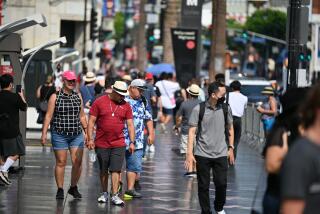S.D. Tourism Posts 4.7% Gain Despite Expo ’86
- Share via
Although Expo ’86 in Vancouver lured away many potential visitors from San Diego, the summer was on balance a lucrative one for the city’s tourist industry, according to figures released by the San Diego Convention & Visitors Bureau (ConVis).
More than 9.4 million people--an increase of 4.7% from last year--visited San Diego during June, July and August. Visitor spending approached $1.3 billion, a 9.6% jump from 1985.
“Compared to all the early ‘80s, 1986 is a pretty good year,” said Michael Casinelli, vice president of CIC Research, which studies trends in tourism for ConVis. “I think it would have been an even greater summer if Expo had not taken place. I think there were a lot of people who wanted to come down here, but Expo was a one-time chance.”
Expo ’86 seemed to make its biggest dent in tourism from within the state, but may have actually attracted more foreign visitors to the West Coast, Casinelli’s research found. The number of people visiting San Diego from other points in California was down more than 28%, but there were twice as many foreign tourists.
Al Reese of ConVis said other possible reasons for the surge in tourists from abroad included lower air fares and the weakening of the dollar compared to foreign currencies.
The number of tourists visiting San Diego from the East and Midwest remained steady, while visitors from Western states--particularly Arizona--increased more than 20%. Reese attributed this to lower gasoline prices, which in turn helped spur a fare war among airlines.
While tourists were, in general, more plentiful and spent more money than in previous years, they also had a lower median income and were more likely to stay in private residences than in hotels, according to a visitor profile developed by CIC.
The profile--compiled from interviews with about 300 visitors a month--indicated that this summer’s visitors had a median household income of $33,907, as compared to $36,703 for last year’s tourists. The proportion of tourists staying with friends or relatives increased from 17% to 22%, while those staying in hotels decreased from 35% to 31%. The percentage of visitors staying in motels remained steady at 22%.
Hotel occupancy in the county ranged from 82% of capacity in June to 88.7% in August, an overall decline of 4.3%. However, more than 3,500 hotel rooms have been built during the last 18 months, raising the total in the county to about 31,600 rooms, said Bruce Goodwin, a senior partner at Laventhol & Horwath, a consulting firm that recently studied the county’s hotel business.
“The number of rooms occupied in the absolute sense is up,” Goodwin said. “You’ve got about a 10% growth in supply and a 4.3% to 4.5% growth in demand.”
With a lower percentage of visitors staying in hotels, the average amount spent per tourist group dropped from $109 to $99, and 21% of this summer’s tourists managed to get by on less than $20 a day, as opposed to 14% in 1985.
“What we’ve found is that visitors who stay in private residences tend to have lower median incomes and lower daily spending, but they do stay longer,” Casinelli said, adding that this is one reason why daily spending went down while total spending increased.
San Diego’s attractions did not share equally in the increased tourist spending. Attendance at the San Diego Zoo and Wild Animal Park increased 12.9% and 12.4%, respectively, while Sea World, after sub-par attendance in June and July, ended up drawing the same number of visitors this summer as last.
The percentage of business travelers during the summer also dropped from 12% to 6%, though Casinelli said the actual number may have been about the same. Convention attendance also remained relatively flat; Casinelli attributed this to the fact that summer is not a prime season for conventions, and to inconsistent reporting of convention business by the city’s hotels.
“Overall, I think we’re doing a pretty good job and the pull of the area is still pretty powerful,” Casinelli said. “We are a very desirable destination.
More to Read
Sign up for The Wild
We’ll help you find the best places to hike, bike and run, as well as the perfect silent spots for meditation and yoga.
You may occasionally receive promotional content from the Los Angeles Times.






